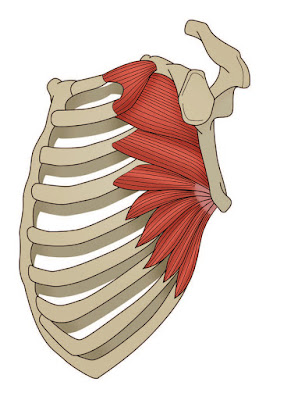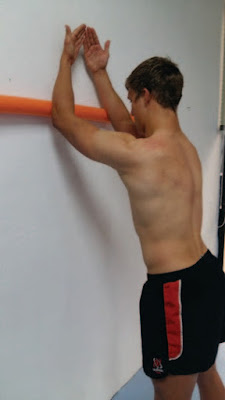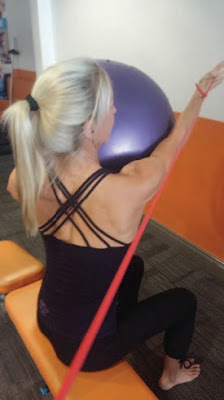Shoulder pain is a common complication which affects many athletes who
participate in overhead sports, such as swimming, tennis and other throwing
sports. Overhead, physical activities primarily utilize upper extremity
movements that place tremendously high demands on the structures of the
shoulder as these often require increased muscular activation around the
scapula-thoracic joint and the glenohumeral joint. Researchers from previous
studies determined that abnormal biomechanics of the shoulder girdle and constant
or repeated overhead movements can lead to injuries in overhead throwing
athletes.
 |
| Share Free Ebook |
Particularly, muscular imbalances around the complex structures of the
shoulder can develop abnormal activation patterns and inherent myofascial
restrictions, both which can cause a significant decrease in the athlete’s scapular
control and dyskinesis, leading to glenohumeral joint injuries resulting from
instability and impingement.
The serratus anterior, or SA, is one of the muscles of the scapula that functions
by providing a connection between the shoulder girdle and the trunk, however, it’s
often believed to be a dysfunctional muscle among shoulder pathologies. The
serratus anterior is a primarily offers movement to the scapula, contributing
to the maintenance of normal scapulo-humeral rhythm and motion. Due to its insertion
on the inferior and medial border of the scapula, it can produce upward
rotation and posterior tilting. Poor activation of the serratus anterior muscle
may result in limited scapular rotation and protraction, causing a relative
anterior-superior translation of the humeral head in relation to its glenoid
articulation, leading to sub-acromial impingement and rotator cuff tears.
Anatomy of the Serratus Anterior
The serratus anterior is characterized as a flat sheet of muscle
beginning from the lateral surface of the first nine ribs. Then, it passes behind
and around the thoracic wall before inserting into the anterior surface of the
medial border of the scapula. The most important function of the serratus
anterior, or SA, is to protract and rotate the scapula, helping to maintain it
close yet away from the thoracic wall, allowing for the proper positioning of
the glenoid fossa to increase the efficiency of upper extremity motion to its
maximum state. The anatomy of the SA can be broken down into three anatomical
components as follows:
First, the superior component of the
serratus anterior begins from the first and second ribs, which then inserts
into the superior medial angle of the scapula. This fundamental section serves
as the anchor that allows the scapula to rotate when the arms are lifted
overhead. These fibres run parallel to the 1st and 2nd rib;
Second, the middle component of the SA begins
from the second, third and fourth ribs, which then introduces into the medial
border of the scapula anteriorly, in between the scapula and ribs. This basic
part is essential for the protraction muscle of the scapula;
And last but not least, the inferior
component of the serratus anterior originates among the fifth to ninth ribs and
inserts on the inferior angle of the scapula. The fibres within this region are
designed to form an arrangement similar to a quarter fan, which then implants
onto the inferior border of the scapula. This third and last portion serves to both
protract the scapula and rotate its inferior angle upwards and laterally. It’s
been previously proposed that the lower section of the serratus anterior
carries out the stability of the inferior border of the scapula, also
functioning with the lower trapezius to create a simultaneous force to upwardly
rotate the scapula during overhead movements for specific sports and physical activities.
Essentially, the serratus anterior primarily operates to upwardly rotate
the scapula during shoulder abduction, principally from 30-degree shoulder
abductions onwards, it also stabilizes and protracts the scapula during
shoulder flexion movements, rotates the inferior angle, or the posterior tilt,
of the scapula, balances the scapula against the thorax during forward pushing
movements to prevent the abnormal function of the tissues, and it also functions
to firmly hold the medial border of the scapula against the thorax to ensure
that it can change the thorax posteriorly during a push up with the hands fixed.
For an athlete, certain movements in particular with their specific
sport or physical activity can require a high level of function from the SA in
order to achieve either full scapular protraction and/or upward rotation.
Examples of athletic performances requiring the function of the serratus
anterior include: throwing a punch in boxing to achieve maximum reach of the
arm. Because of this, the SA is frequently referred to as the boxer’s muscle.
Among boxers, the serratus anterior is crucial for the scapula to be able to
brace on impact with the punch, allowing for maximum transfer of force from the
lower limbs into the torso for it to transmit into the upper limb and punch. If
the scapula were to collapse from the impact of a punch, the boxer would then
lose power in their punch. In swimmers, a full upward rotation is necessary for
the athlete to achieve a maximum reach in the water upon hand entry in freestyle
and butterfly swimming. An overhead athlete, such as a tennis player, utilizes
a full upward rotation when serving. Among the sweep style rower, the athlete
needs full protraction on the longer region to achieve the required reach
during the catch phase of the rowing stroke. And in baseball, for example, the
pitcher requires high levels of protraction to follow through with a pitch,
similarly, in the throwing events in athletics.
The long thoracic nerve can be found within the serratus anterior, which
originates from the fifth, sixth and seventh cervical nerves. These nerves then
pass through the scalenus medius muscle before they another cervical branch of
nerves which travels through to the scalenus medius as well. The long thoracic
nerve then passes through the brachial plexus and the clavicle to pass over the
first rib. In this section, the nerve enters a fascial sheath and continues
traveling along the lateral feature of the thoracic wall through the serratus
anterior muscle.
SA Dysfunction & Scapula Dyskinesis
The proper
positioning of the humerus within the glenoid cavity, best referred to as the
scapulo-humeral rhythm, is essential towards the proper function of the
glenohumeral joint during overhead movements. Any alterations in the normal
motion of the scapula may cause an inappropriate positioning of the glenoid
relative to the humeral head, causing injury to the SA due to impingement and
instability and resulting in shoulder pain and other symptoms. The right use of
muscle activation and the adequate levels of muscle recruitment are also needed
to position the scapula in the proper position. Small changes in the activation
of the muscles around the scapula can affect its alignment as well as the
forces involved in upper limb movement. The serratus anterior is one of the
primary muscles responsible for maintaining normal rhythm and shoulder mobility.
Several healthcare professionals have helped reduce the pain caused by
impingement by actively repositioning the injured individual’s scapula into a
proper posture by reducing its anterior tilt, increasing the strength of the
shoulder during overhead activities. The SA is a muscle that actively functions
to position the scapula into posterior tilt during specific sports involving
overhead motions.
If there is a lack of strength or endurance in the SA, the muscle also
allows the scapula to rest while in a downwardly rotated and anterior tilted
position, causing the inferior border of the structure to become more
distinguishable. Moreover, an imbalance between the serratus anterior and the
other muscles surrounding it, such as the pectoralis minor, may result in what
is known as a winging scapula. Scapular winging may speed up or contribute to
the development of constant symptoms among athletes with orthopedic shoulder
pain and injuries.
Scapular winging can be identified by observing the position of the
scapula during a push up exercise. Often, if the winging is due to a muscle imbalance
and the primary scapula stabilizer is the pectoralis minor, this will generally
correct itself if the individual is asked to protract their scapula. If the
wing disappears then the cause is most likely muscle imbalance and if it remains,
then it may be a pathological inhibition of the SA. Other instances of scapular
winging can also occur due to pathological damage or injury to the long
thoracic nerve found within the serratus anterior muscle.
The Significance of the SA
The necessary conditioning of the serratus anterior muscle among an
athlete has been previously evaluated in studies regarding sports such as
swimming, throwing, and tennis. A fatigued SA muscle can ultimately reduce the
rotation and protraction of the scapula, which allows the humeral head to change,
most commonly leading to secondary impingement and rotator cuff tears. Further
studies on the role the serratus anterior plays in shoulder pathologies has also
been analyzed by many other researchers. Some of the most important and
noteworthy key points have been summarized and recorded by researchers as
follows:
While the researchers conducting these studies evaluated the trapezius
and serratus anterior among individuals suffering from shoulder pain and
injuries, it was compared with those without damage or injury to the shoulder,
and it determined that the upper trapezius can demonstrate increased activity
during the raising and lowering of the arm. The results show how the SA can
decrease activation at some elevation angles.
Then, the study also evaluated the muscle activation patterns of
swimmers with shoulder pain, comparing it to those without, and found that the
middle and lower serratus anterior decreased activity in all phases of swimming
motion. This can be a possible cause for shoulder pain or other complications
where the swimmer uses compensatory muscle activation patterns.
Scapular Winging & Winging Correction #1
Similarly, other researchers have identified an inactivity or activation
delay in the SA surrounding the painful shoulders of swimmers while they raise
their arms in the scapular plane. It’s also been previously hypothesized that
individuals with decreased serratus anterior activations have a closer
association with an increased chance of developing shoulder pain and/or
instability while the increase in lower trapezius activity may function to
compensate for decreased serratus anterior activation. Other studies relating
to various types of shoulder dysfunction, found decreased serratus anterior
activity and increased upper trapezius activity, without a change in lower
trapezius activity among subjects with shoulder injuries when compared to
subjects without shoulder complications.
Scapular Winging & Winging Correction #2
The specific position of the scapula has also been associated with the
rotator cuff’s ability to function effectively. An excessive anterior tilt of
the scapula, an internal rotation or an excessive elevations of the acromion
are elements which can decrease rotator cuff activations, ultimately causing insufficient
handling of tension along the tendons. These circumstances can debilitate the length-to-tension
ratio of these muscles, leading to the loss of stabilization and an increasing
risk of muscular disruption or degeneration within the serratus anterior or
other tissues surrounding the shoulder. It’s been demonstrated that the
function of the rotator cuff can improve the functioning of the scapula
muscles, primarily the SA and lower trapezius.
Exercises for SA
A considerable amount of research has been conducted to find the best
rehabilitation exercises for serratus anterior muscle damage or injuries. The majority
of these studies analyzed the specific movements performed during push-ups,
push-up-plus exercises and cable/dumbbell punch type movements. These exercises
basically emulate the function of the SA in its protraction role. The studies
noted several important findings.
First, resistance was applied with eight scapulo-humeral exercises
performed below shoulder height that target the SA muscle in order to design a
progressive rehabilitation plan of serratus anterior muscle exercises along
with training. According to these researchers, the best exercises are push-ups,
dynamic hugs, scaptions and SA punch exercises.
The studies are found interesting effects of
vibration on the activation of the serratus anterior muscles and found that the
push-up plus exercise performed increased SA muscle activity. Additionally, the
effects of an unstable surface on the upper and lower parts of the SA while
performing variations of the push-up exercises were evaluated and the results
indicated that different parts of the serratus anterior have distinct functions
towards the stabilization process of the muscle. The authors of the study
concluded that the main role of the lower SA is the fixation of the scapula
onto the thoracic wall. Furthermore, they recommended athletes should perform
the push-up plus on an unstable surface as a more effective strategy for the
specific mobilization of this component of the SA.
The following exercises are examples of clinically used serratus
anterior activation exercises which have been proven to increase the levels of
function.
Shoulder Strengthening
The above
shoulder strengthening stretches and exercises can also help strengthen the
muscles surrounding the shoulder which can help prevent injuries and other
complications common among many athletes. Performing the following stretches
and exercises can be beneficial towards the rehabilitation of damage or injury
to the serratus anterior muscles. Before participating in any form of physical
activity after suffering an injury, make sure to consult a healthcare professional
on the recommended workout routines for each individual.
Wall Slider
To perform
this exercise, using a foam roller or pool noodle on the wall, place the wrists
against the roller with the forearm in a neutral starting position. Then,
protract the scapula so the space between the shoulder blades fills with an
increase in thoracic kyphosis. Slowly flex the shoulder so the roller moves up
the wall, making sure to supinate the forearms, to reach as high as possible
into shoulder flexion. The finish point is when the little fingers touch and
the forearm is in maximum supination. Slowly descend and return to the starting
point. Perform three sets of ten repetitions.
Swiss Ball Rotations
The athlete
can perform this exercise by holding a Swiss ball between the arms with the
ball gently resting on the chest while the forearms are in a neutral position. Then,
slowly rotate the trunk to the left. The arms will glide around the Swiss ball.
As the arm protracts, slowly rotate the palm upwards to encourage supination of
the forearm and external rotation of the shoulder. Return to the start
positions and start again.
TrX Serratus Rollout
The
individual participating in the exercise should first place the forearms
through the loops of a TrX or other suspension device, placing the straps at
wrist level or just below the elbows to differentiate the exercise load. The
start position is similar to that of the wall slider above followed by slowly
flexing the shoulder to elevate the arms above the head while slowly externally
rotating the shoulder by supinating the forearms. The finish position is when
maximum flexion/elevation is achieved and the little fingers touch. Return to
the start position and perform three sets of fifteen repetitions.
TrX Push Up Plus
The athlete
participating in the exercise should first position the handles on a TrX about
two to three feet off the ground. Holding the handles in a push-up position,
slowly perform a push up and slowly screw the hands into supination and
shoulder external rotation. At the top of the exercise movement, protract the
scapula and fill in the space between the shoulder blades with a slight
thoracic kyphosis. Return to the bottom position and perform three sets of ten
repetitions.
In conclusion, the serratus anterior, or SA, is a muscle that plays an essential role
in the movement and control of the scapula during pushing movements and
overhead activities. Specifically, it is a protractor, upward rotator,
posterior tilt muscle of the scapula and additionally, it fixes the scapula
against the rib cage during movement. Ultimately, It is a crucial muscle for
the overhead athlete as dysfunction in this muscle can lead to shoulder
injuries such as impingement, rotator cuff tears and performance issues during
overhead tasks.
By Dr. Alex Jimenez

















